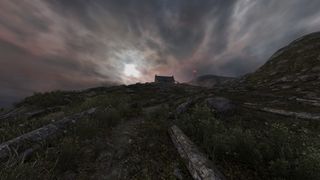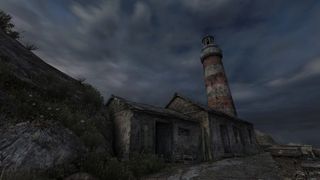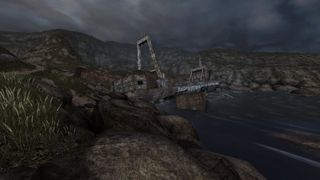
The thing with Dear Esther is that everything is supposed to invoke the feeling of isolation, of being completely and totally alone. There are moments when the music drops out and leaves you with nothing but the crunching of stones underfoot and the wind desolately howling in your ears.
These introspective moments serve a very good purpose, and it's not to make you uncomfortable or out of laziness. Dear Esther isn't a game where you'll be running from enemies or killing things but is one for the player to interpret their experience themselves. It's not that straightforward of a game.

The Landmark Edition of Dear Esther contains directorial commentary by the developers, The Chinese Room, and they strongly emphasized in the dialogue that this isn't a game where they're going to tell you with audio or visual cues how to feel. This is really important, as so many games these days will hold your hand — telling you how to feel, assaulting your every sense with jump scares and strange noises until you're stressed and quivering behind the sofa.
Everything about Dear Esther is supposed to invoke the feeling of isolation.
You won't find jump scares in Dear Esther. The scariest thing is the character's dreadfully slow movement speed. For all intents and purposes, Dear Esther is a story-lead exploration game — a walking simulator, if you will. The walking speed is so terribly slow, I felt myself getting stressed because I wasn't moving fast enough. This makes sense in retrospect as the game is only around two hours long, and increasing the walking speed would have drastically cut the time actually spent in-game.
Second to this, there is no jump button. So when I got stuck on the second level, looking at the shipwrecked boat on the shoreline, trying to figure out if there is a way I could climb onto it, I got trapped between some boulders. This didn't seem like a big deal at first; when I first started the game, I walked onto the beach and tested the movement, seemingly able to glide over what should be a good couple of feet difference in ground level. When I got trapped between the boulders, there was nothing to do but to restart the level. This was a pain in the butt since there are no mid-level checkpoints, and I'd already done a fair amount of walking around the level by this point.

I was surprised that the main story is only two hours long, but checking my stats via the Xbox One achievements board, I discovered I'd only uncovered roughly 33% of the story in that time. If I start another game, items in the game will be new and randomly strewn throughout, giving me a fresh experience. This way players all have unique encounters and interpretations each time they play the game. Such is the variety, that two players could discuss the game and both have drawn completely different conclusions from it.
Dear Esther is 'a remake of a remake of a Half-Life 2 mod', so the developers took care to balance the writing and the music with stunning visuals, which I feel has been achieved with flying colors. The quality of the graphics was way beyond what I was expecting, with clean textures and crisp animations. This helped the entire overall experience become a much more enjoyable one, it created a more immersive and realistic environment for me to stumble around in.
I often found myself just stopping a moment and taking in the environment around me. At one point I was in a cave, and it felt like I was surrounded by stars, tiny points of light sparkling from every surface in an otherwise black space. Later, I took in the breathtaking reflection of the moonlight on the water. I'm glad I didn't have the distraction of having to hide from enemies or bracing for a fright to draw my attention from the superb attention to detail.

The sound was just something else. Having grown up in South East England, I'm no stranger to hearing the wind howling and rain battering against the windows, but it never sounded as lonely as it does in Dear Esther.
Loneliness is a big thing in Dear Esther. There is a moment near the start when the character comments on some man-made markings on a cliff face. These markings were used to warn others that there is sickness, disease or something deadly on the island, or just to tell people to keep away. The character mentions that he may have made the markings himself if only to keep people away more than anything. It's not clear how long ago this character washed ashore, but he's clearly gone a bit mental.

The "Esther" of the title is the late wife of the character, lost in a drunk driving accident. The "Dear" takes the form of his letters to her, sending them off to sea, knowing she will never read them. There are other people mentioned: Donnelly who had been to the island before; Paul, who may be the man's wife's inadvertent killer; and Jakobson, a shepherd who lived on the island a couple of hundred years ago.
The different characters and the narrative are told depending on which fragments of letters you come across (this happens automatically, there's nothing isn't anything you have to physically look for), leaving you to piece together what significance these characters have to the story.
As the character takes his final bow, I had tears rolling down my face, though I couldn't completely understand why. Perhaps this unnamed man had gone mental in losing his wife and sought out a place to be alone until he was ready to follow her into the abyss. Perhaps he was already so lonely without her that he thought solitude could be his panacea. Whatever he thought, one play-through left me with more questions than it had even begun to answer, and by the end of the second play-through, I was raving with theories about who this character was and what the narrator meant beneath all his flowery prose. The second time filled in gaps, I locked onto certain things I'd heard previously and noticed things that were different. In hearing both sides of this narrative style, I feel I got a much better grasp on what the story is about.

Summary
Dear Ester, is in no uncertain terms, amazing. Its mysterious storytelling, haunting soundtrack and stunning visuals create an experience you won't want to wait to throw yourself back into.
Pros:
- Incredible visuals
- Mysterious and compelling narrative
- Beautifully composed soundtrack
Cons:
- Dreadful walking speed, but understood as it would limit the length of the game.
Lauren Relph is a games writer, focusing on Xbox. She doesn't like piña coladas but loves getting caught in the rain. Follow her on Twitter!

